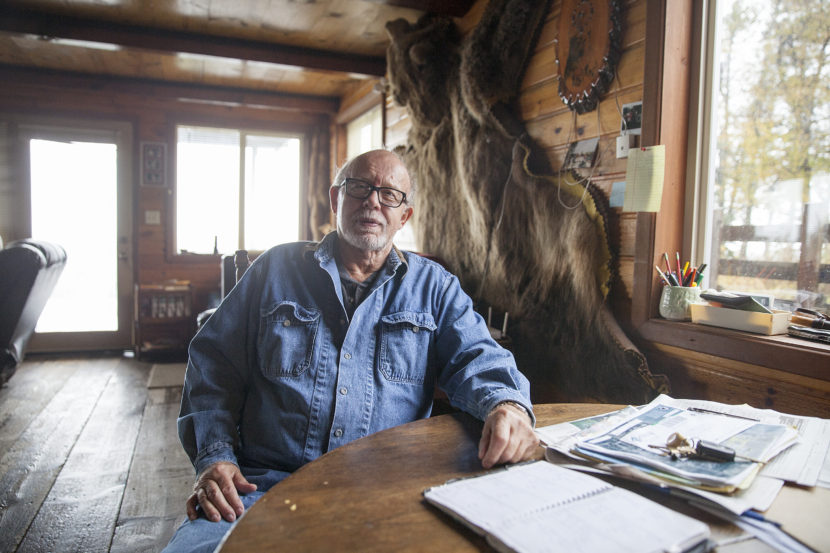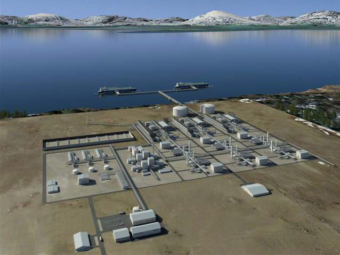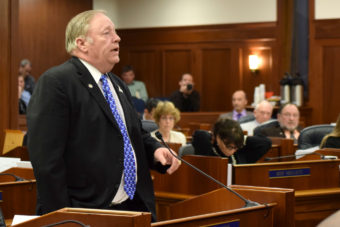
Over the last two years, the Alaska LNG project bought about 630 acres of land in Nikiski, on the Kenai Peninsula. That’s where the state and its partners hoped to build a giant natural gas liquefaction plant — and several homes were razed.
But now, the project’s future is uncertain — and so is the fate of that land. Those left behind in Nikiski aren’t sure what the community will look going forward.
Bill Warren’s house at the end of a long gravel driveway, tucked into the trees near a bend on the Kenai Spur highway. It’s easy to miss. The driveway just south of his is on land owned by the Alaska LNG Project LLC. The lot is vacant and papered with no trespassing signs.
There used to be a house there.
“They tore it down. I built it and my mother lived in it,” Warren said.
Warren is one of the holdouts in this neighborhood.
They’re among the many residents of this small, unincorporated community whose properties but up against land owned by the Alaska LNG project. But, for whatever reason, they refused to sell.
Since 2014, the state’s three oil company partners in the Alaska LNG project — ExxonMobil, BP and ConocoPhillips — bought nearly 150 parcels of land in Nikiski.
The area could eventually house a massive plant where North Slope natural gas would be processed and then exported.

But, for now, all of that’s on hold.
On some of the land, the companies tore down the houses. It’s not clear when — or if — the promised project will replace them.
Warren is not happy.
“Well, they ruined us. I always call us a village,” Warren said. “We were a bona fide village here with people and businesses and they just cut a swath through here. Cut 600 acres out, tore the houses down and left us and I don’t like it.”
Warren has been in Nikiski since the 1969, and he’s no stranger to industrial development.
Just to the north of his home, the ConocoPhillips and Agrium docks jut out into the inlet. There’s a tank farm nearby. Helicopters regularly hug the shoreline and fly along the bluff in front of his property.
He shows off a cabin he built using money from Exxon — paid to him in exchange for putting a road through a thicket of his trees.
“We’ve been working on it all summer. It’s a nice little, cute little place,” he said, pointing at the small cabin perched on the edge of his bluff.
There are no trees blocking his panorama of the Cook Inlet.
Just a mind-boggling expanse of sky and water.
The Redoubt volcano looms on the horizon — and, of course, there are the offshore platforms.
Warren’s a welder. He helped build a lot of the infrastructure in Nikiski.
And all that infrastructure is one reason the Alaska LNG partners chose Nikiski as the end of the line for North Slope natural gas.
The Nikiski industrial area has four major petrochemical-processing facilities and is one of the largest existing industrial complexes in Alaska.
With low oil and gas prices challenging the economics of the megaproject, ExxonMobil, BP and ConocoPhillips announced that they wouldn’t invest in the next stage of the project.
Now, the workers on the Kenai Peninsula taking soil samples and testing the water are gone, and the project has shut down its land purchase office. The state has taken over the project, but details on the transition are hard to come by.
Warren said he got a letter in September from Paragon Properties, the company handling land purchases for the project. It said they were suspending negotiations.
And that leaves people like him in limbo.
“It’s left us where we don’t really own our property. I mean, we do legally. But our plans, our hopes, our dreams we can act on because it’s all on hold,” he said.
Those 630 acres in Nikiski are a linchpin of the state’s plans to take over the project.
If the state wants to move forward with permitting the project, then it must prove to the Department of Energy and the Federal Energy Regulatory Commission that it has access to that land.
“You have to show that you have control of the land — either through ownership of the land, a long term lease on the land or the option to buy the land. Because, without land, just like without a pipeline, without gas, without financing, you don’t have a project. And, the agencies are not going to accept a hypothetical project unless you can show that you have control of that land,” said Larry Persily, Kenai Peninsula Borough oil and gas adviser.
Persily said the federal government doesn’t care how the state works out a deal with the companies that currently own the land — buying it or signing a long-term lease — just that it does.
The state hasn’t released any details about how it’s going to do that.
It’s not clear whether the Alaska Gasline Development Corporation, which is heading up the state’s effort, has the money to buy nearly $30 million worth of land.
The corporation wouldn’t make anyone available to talk about its plans.
In a written statement, spokeswoman Rosetta Alcantra said it is currently negotiating with the producers.
The lack of information has left residents frustrated.
House Speaker Mike Chenault, R-Kenai, whose district includes Nikiski, said the flurry of land buying in the area raised expectations in the community — expectations that now may not be met.

“I’ve tried to explain to folks, they can go buy 600 acres of land. It’s $20 million or whatever. That’s nothing compared to a $65 billion project,” Chenault said.
For Warren, that hope has given away to frustration.
He tends to get worked up when he thinks about the future.
He’s become a well-known fixture on the local morning talk-radio circuit, calling in to complain about what the project has done to the community.
“I’m fearless. What the hell can they do to me? I’m 75 years old and they can’t withdraw me from work or anything and I pay my taxes, so they gotta listen,” he said. “Imagine cutting a swathe through Anchorage like that.”
If the Alaska LNG project does go forward, then it will need another 200 acres to piece together the site for its Nikiski plant.
Editor’s note: A previous version of this story incorrectly referred to a agency, it is the Federal Energy Regulatory Commission.
